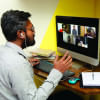Why everyone should learn sign language

Sign language has existed for a long time, yet it isn't as prevalent as it should be, which leads to the exclusion of many individuals with hearing impairments.
Over time, sign language has undergone many changes. Linguistic researchers believe this communication method via gestures and symbols has been around for as long as spoken language. Quotes from renowned philosophers like Socrates lead us to believe that a visual system of communication for people who were unable to speak existed centuries ago.
However, Aristotle's opinion of people with hearing impairment negatively impacted the adaptation of sign language, as he believed auditory senses were necessary for humans to learn.
Despite this idea being from the fifth century BC, it took until 17th century France for the first documented and widespread use of sign language in Western society.
There are many forms of sign languages in different parts of the world. British and French Sign Languages are the most commonly used ones in Europe. The American Sign Language (ASL), on the other hand, is more common in the United States and adjacent countries. However, there is no universal sign language, different regions use different versions of it.
There are Chinese, Australian, and Brazilian sign languages among many others. Bangla Sign Language is the one used for Bangla, although it is not as common as the ones mentioned earlier.
In Bangladesh, sign language is taught to individuals with severe or profound hearing loss and speech impediments. People with mild to moderate hearing loss, however, are rarely taught sign language as they're mostly encouraged to improve their hearing through hearing aids.
The same goes for individuals with slight speech impediments. They're encouraged to do speech therapy, but do not learn sign language alongside it.
Sign language shouldn't just be limited to people whose impairments call for it. For people with said impairments to communicate effectively using sign language, others must also put in the effort to learn it.
If nobody, aside from their immediate family members, ventures to learn the language, their communication opportunities become limited.
Sign language is also an excellent tool to communicate with the elderly who experience hearing loss. While learning the language needs a bit of effort at that age, it spares everyone from yelling at the top of their voices ineffectually.
Sign language also has uses outside of communicating with people who have limitations in terms of verbal conversations. The language comes in handy when relaying messages to others in a noisy environment or situations where speaking isn't an option. Sending hand signals comes in the clutch in emergency situations too.
Learning sign language by oneself is difficult, which is why it should be incorporated on a bigger scale so it can be accessible to everyone. Signing is sometimes included during news segments on several channels, but it should be utilised in live telecasts and live programs too.
To draw a conclusion, learning sign language is an important skill. Knowledge of sign language only makes life easier for all parties involved, and it can help you get closer than ever to loved ones in need.
Find Zabin Tazrin Nashita at fb.com/zabintazrin.nashita

 For all latest news, follow The Daily Star's Google News channel.
For all latest news, follow The Daily Star's Google News channel. 








Comments